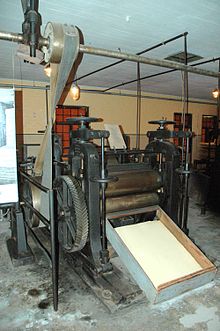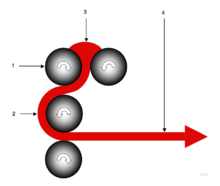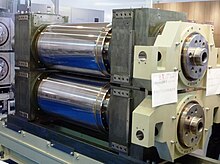calender

Calender (of French. Calandre "roll") is a system consisting of several successive arranged heated and polished rolls from chilled cast iron or steel , through the columns of a melt are passed, or other materials. It is used to manufacture foils made of plastics ( PVC , PE , PS etc.), rubber, metals ( aluminum , tin ) and paper.
Distinguishing features
A distinction is made between melt calenders for film production (semi-finished film) and coating calenders for coating z. B. fabrics , e.g. B. conveyor belts. A distinction is made between the designs of a calender. These are based on the arrangement of the individual calender rolls in the side view. The L, F, I and Z shapes are common.
In deviation from this usage, DIN 8580 (System of Manufacturing Processes) places calendering (1.2.6) as primary forms from the plastic state , i.e. it only includes melt calendering . Coating is an independent basic group (5). In practice, the actual primary shaping, forming (basic group 2, e.g. smoothing) and other reworking are also combined in one production plant.
Calender types
Depending on the arrangement of the rollers and the material feed, a distinction is made between I, L, F and Z calenders. The L-shape is mainly used for processing hard PVC. Soft PVC processing can be implemented in the F-shape, fabric webs in the Z-calender.
Applications
Calender also for embossing , smoothing , compacting and calendering of paper and textiles used. Furthermore, nonwovens made of thermoplastic polymers can be consolidated into nonwovens. There are also elastomeric calendered -Mischungsplatten for the production of transport conveyor belts.
Textile industry
In the textile industry calender or modules can be used from a plurality of calendering in a variety of ways, including as a preliminary step in Krumpfungsprozess , for smoothing surfaces to squeeze off excess liquor, when heat-setting or fleet residues to evaporate ( hot calender ).
Paper industry
In the paper industry , surface properties such as gloss and smoothness are improved with a simultaneous reduction in thickness. Various effects can be achieved by changing pressure , temperature and roller speed. Calenders are located outside the paper machine (offline) or inside the paper machine between the dryer section and the reel (online).
The process is called calendering or satinizing .
Plastics industry
In the case of plastics, comparatively thick films are produced using the calendering technique. These then come z. B. in the pharmaceutical industry for blisters ( transparent packaging ) used. Thin films made of PE (garbage bags) are produced by means of blown film extrusion , for example to save time and money . Rubber films are produced in the range from 0.03 to 1 mm. These foils are also relined in the calender.
screen printing
Steel gauze fabrics for the screen printing process are partly calendered to smoothen and reduce the thickness after weaving (mostly at the request of the printing company, who is doing the printing). Thickness reductions of between 15 and 50% are common; the more the fabric is rolled, the more optically it becomes a metal foil.
Manufacturing
In designing calenders, engineers face several difficulties. As a rule, the applications require an extremely finely adjustable distance between the rollers, the width of the goods should be as large as possible, the rollers should have as little mass as possible, but withstand high pressure. Due to the last three requirements mentioned, it is often unavoidable that slight bending effects occur along a roll (deflection), and also often thermal deformations. This is taken into account by (mostly tiny) deviations from the cylindrical roller profile. Barrel profiles (crowned, ground roll balls) that are slightly thickened in the middle, two counter-rotating trapezoidal profiles and S-profiles are used. The thickening is also referred to as a so-called bombage . The last two profiles have the advantage that fine adjustments to the distance are possible by changing the position of the rollers. The rollers can be changed in the roller spacing parallel to one another or they can be set. When setting the roller axes are no longer parallel.
Especially in the high-speed calenders of paper machines , the vibration behavior is dampened by anti-vibration compounds in order to avoid tears in the paper webs despite the high speeds.
See also
Web links
Individual evidence
- ^ Fritz Röthemeyer, Franz Sommer: Kautschuktechnologie , Carl Hanser Verlag Munich Vienna, 2nd edition, 2006, pp. 529-576, ISBN 978-3-446-40480-9 .
- ↑ Die wire weavers: processing & finishing - calendering [1]


